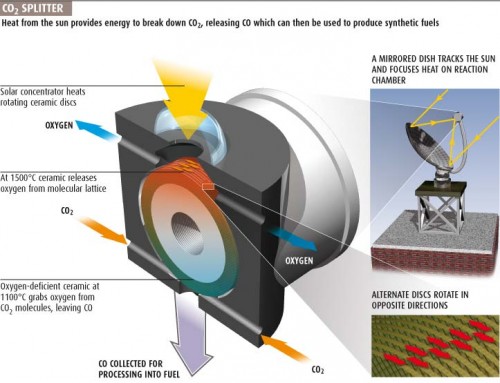Or the CR5. It takes CO2 and converts it to a liquid hydrocarbon fuel that will burn in any petroleum engine by using the power of sunlight to add heat to a chemical process that strips away one oxygen molecule, turning CO2 into CO.

The only catch that should be mentioned right off the bat is that when that new carbon monoxide based liquid fuel is combusted, CO2 is released again. But as long as there is always a way to sequester the emission, sunlight and a CR5 type device available at the sequestration point could make conceivably create an infinitely recyclable loop (with a single digit efficiency perhaps). The first application would be to use it on the huge CO2 polluting power plants.
It is all very far off and theoretical for now with the horizon for marketability beyond 20 years. But one of the comments notes that the aviation industry may be able to make use of this type of thing around 2040 as a transition tool as the rest of the world has moved to a clean electric economy but while it is still not yet feasible to fly commercially sans combustion.
It is basically a very fancy and complex artificial photosynthesis machine. Some forms of microbial photosynthesis also create CO as the first stage to carbohydrate production.
via:
Inhabitat, Psyorg, Technology Review, Gas2.0, Popular Science
Related Posts
3 Comments
Add comment Cancel reply
This site uses Akismet to reduce spam. Learn how your comment data is processed.


What is the process to make this machine in easy way
[…] planted to power the bloom boxes of the world. On the perimeter are beautifully designed carbon-sequester-to-fuel devices that, combined with the capacity of the grass, will offset the bloom box CO2 emission. […]
How far has the technology progressed since this article was published? It looks a great deal more feasible than carpeting vast swathes of the earth in war of the worlds style windmills.